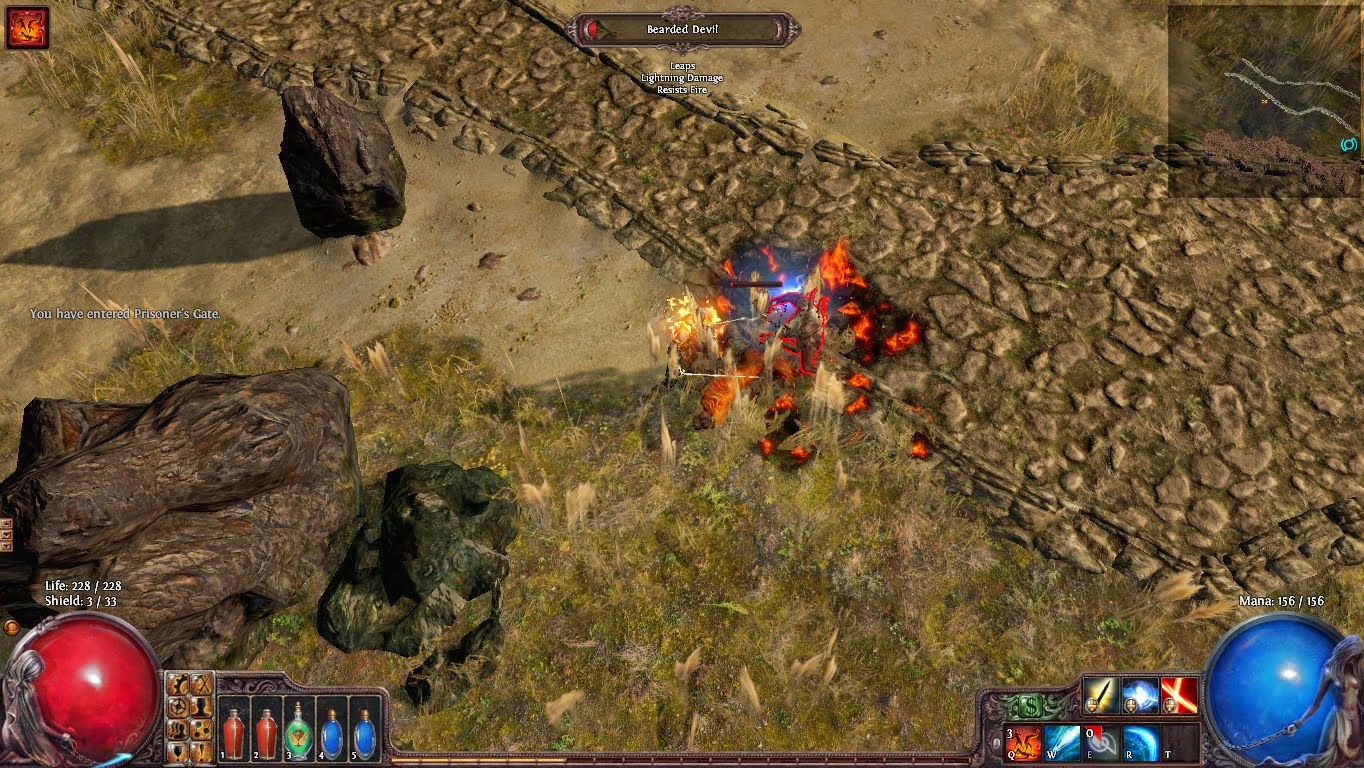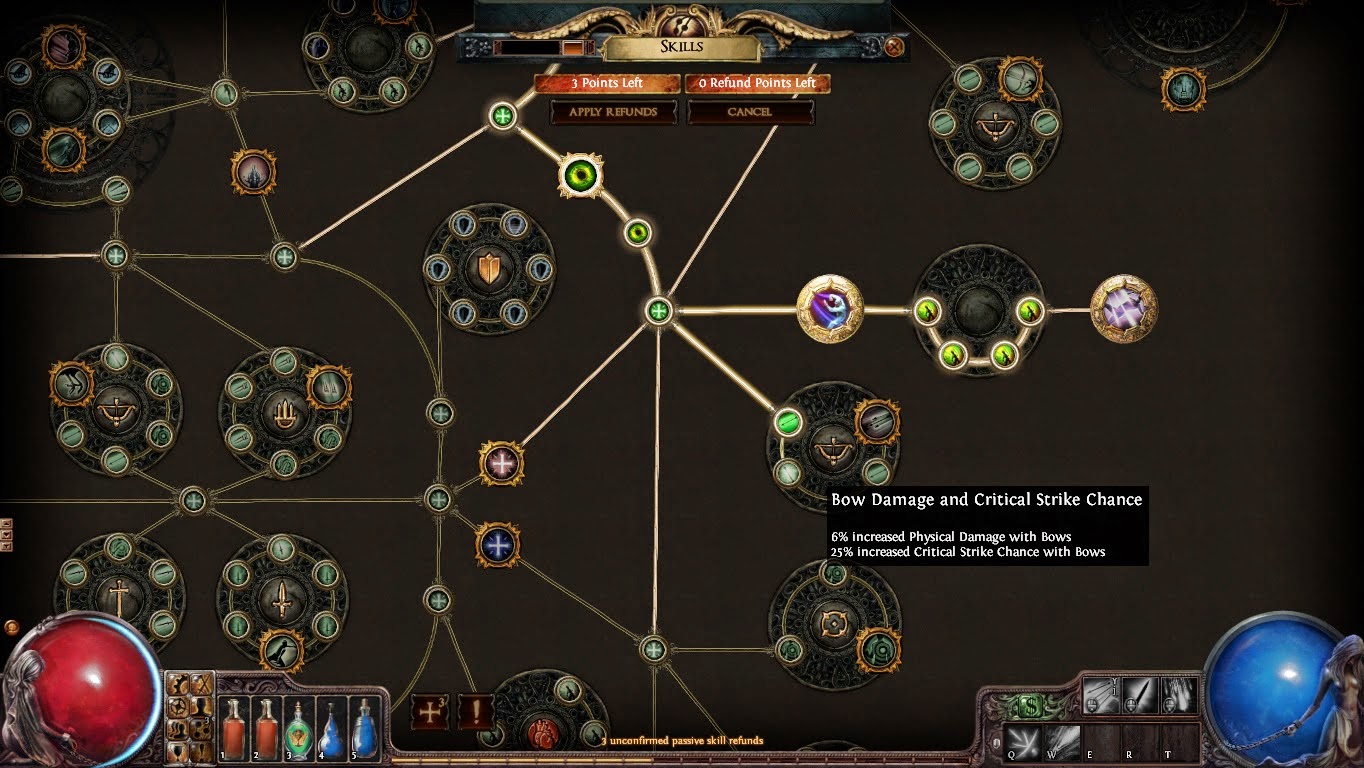Of sprawling forests, sprawling caves,
sprawling dungeons and sprawling ability trees.
 |
| Always online can be annoying, but it's a fair trade off for the fact that the game is free. |
Path
of Exile is a strange game that seems to defy all conventions of existing. Yes,
it’s a free to play game, in the truest sense, akin to Valve’s Dota 2. The only
difference here is that ‘Valve’ is a company automatically synonymous with
several beloved titles, great love for quality and lots and lots of money. On
the other hands ‘Grinding Gear Games’ is a company that is a bit of a blank
slate and one that’ll make you think of the numerous RPGs in which you, well…
grinded for gear. Which is a bit of a nice move since Path of Exile is modelled
after Diablo and Diablo 2, both games in which grinding for great gear and
hunting for epic loot formed an important part of the experience.
Before
I start to talk about the game I think I’ll take a moment to muse upon how
prisoners are now one of the core fundamental starting points for most RPG
protagonists. Amnesiacs have lost much of their importance these days, likely
being stranded in their cells and wards these days instead of being sprinkled
over various fantasy landscapes and settings. Prisoners, on the other hand have
broken out of their old shackles and been strapped with new shackles in various
fantasy settings. The good thing for them is that these shackles will soon be
broken by fate itself while they’re swept into a series of epic stories and
conflicts. The reasons for their imprisonment left to ambiguity and the dust.
Path
of Exile took the trend of prisoners-as-protagonists and made some rather
amusing and logical use of it as a setting… hence the name ‘Path of EXILE’. The
classes in the game are more akin to characters in the way that their
appearances and gender are fixed, with their own backstory as to why they’re on
the path of exile (heh). You’re given a reason for your character’s exile and
it’s all wrapped in a very deprived and oh-no-we’re-all-going-to-die package,
complete with lots and lots of zombies. A Diablo staple.
 |
| My faith is my shield and my weapon. |
 |
| You're already dead. |
 |
| I have an apron. |
Talking
about characters, there’s a pretty charming amount of personality to each
class, from the Templar exclaiming about ‘FAITH’ and ‘GOD’ ever so often, or
the Shadow’s snarky remarks, or the Witch’s ‘I’m going to burn everything and
eat your children’ nature. Honestly, playing the Witch was a bit of strange
experience since you can’t help but go into a bit of introspection whether
you’re the truly evil character in that equation as she talks about how
beautiful some abominations are and seems to almost evoke hatred for those
trying to live blissful lives filled with more life than death. The Shadow, on
the other hand, has this apron of weapons equipped permanently that makes him
look like a travelling roast enthusiast, ready to carve into anything served to
him. Well, I suppose ‘ready to carve into anything served to him’ does suit his
character, a pseudo-vengeful assassin who doesn’t care much for vengeance, but
I said that line with things like turkey and steak in mind, not zombies and
angry cannibals.
 |
| It's not a Diablo-like without Goatmen. |
Path
of Exile exists in a fairly cyclical, powerful paradox. It is very
run-of-the-mill but it is also very, very unique. Both at the same time. You
watch it, you play, you see it, you touch it, and it’s obviously very, very
Diablo. Down to the art style, which is arguably more akin to Diablo than
Diablo 3 itself, with its washed out and grim yet colourful world. But it
breaks some moulds that seem to have set into the Diablo formula, for one there
is the lack of an Act set in a desert. A Diablo-like game without a desert?
Shocking, isn’t it? It also trades out skill trees and stats for skill gems and
a GIGANTIC MAZE OF THINGS. Well maze is perhaps not accurate, let’s just say
the ability tree is much more tree-like than most trees. The skill gem system,
while not new, is executed in a simple and effective manner, and the ease with
which you can swap them around lets you play around as you desire. The
existence of skill augmenting gems and benefits for linking gems can make for
some fun combinations. And these gems combined with the GIGANTIC ABILITY TREE
can make for some ponderous sessions of theorycrafting and build-planning.
 |
| Behold, the GIGANTIC ABILITY TREE. |
Unfortunately,
all the classes play very similar to each other at a basic level. In fact, the
classes are less akin to classes in the traditional sense, and more akin to
classes in an almost Elder Scrolls or Dark Souls sense, with the class just
being a hangar for you to build your character on. All weapons, armours and
gems are available to all classes, and the core difference for the classes
being that they start on various locations of the GIGANTIC ABILITY TREE with
varying paths on the GIGANTIC ABILITY TREE. And yes, I’m casually denouncing
the usage of pronouns just so I can use GIGANTIC ABILITY TREE repeatedly. The
downside to this is that the classes tend to start out playing similar, with
the potential to be played the same way. Sure, the Shadow can be built as a
character focused on quick strikes bolstered by magic, but he can also play the
ranged game with a Bow, effectively turning into a Ranger. While the class
differences tend to shine when you get skin-deep into customisation and builds,
at a basic level the classes are all very similar. Hell, the only difference
between my Templar and Ravager in the first 10 levels lay
in the fact that I picked up an AOE Ice spell with my Templar, little else. And
despite how gigantic the GIGANTIC ABILITY TREE is, the impact of your points in
the GIGANTIC ABILITY TREE aren’t always that impactful. You will generally end
up spending many levels allocating points into meagre passive bonuses, which
add up significantly in the long run, but don’t have any pizzazz to them, not
until you invest heavily in a line to unlock its character-changing signets
(such as one which causes spells to drain health, instead of mana). And while
the basic skill gems are a bit dull, there are a fair share of interesting
ones, be it a skill or augment gem, to be found down the road.
 |
| Some interesting power-ups are scattered across the land. Allowing you to wreak mass havoc, more so than you already were. |
Personally, I’m
still interested to dive back into the game to back a build that will make use
of a ‘Cast of Melee Kill’ augment gem, thinking of the AOE damaging spells,
buffs or summoning spells that I could couple it up with. The potions have also
received an innovation overhaul, instead working in ‘charges’ that refresh as
you kill enemies, allowing you to keep adventuring. Furthermore these potions
are items which you equip, and can have their own benefits and enchantments,
and they ‘fill’ as you kill.
 |
| The map obviously harkens back to Diablo 2's. |
The
game is a borderline dungeon simulator, because there are a lot of dungeons in
this. There’s a bit of variety to the dungeons, but the dungeons are still
dungeons, and nothing is going to change the basic aesthetic of a dungeon. You
want to know how dungeons look? They look a bit drab, dreary and tend to be
quite dark. Want to know the common feature of all the dungeons in this game?
They are all a bit drab, dreary and tend to be quite dark. Caves also tend to
suffer from this, as they tend to be drab, dreary and quite dark, just with
more NATURE and less MAN in the equation. The flora and fauna still want to eat
your intestines every bit the same amount though. The environments and many of
the enemies reeked of the been-there-done-that (or been-there-killed-that)
problem, since nothing really stands out as particularly mind-bogglingly unique
or crazily creative. Though there is one interesting dungeon (in the
non-aesthetic sense of the word, in the gameplay sense of the word) that has
pretty strange enemies that you are sure to have not expected to fight.
 |
| Heal - Shoot - Move - Heal - Shoot - Move |
 |
| Basic enemies tend to just keel over and die. |
Combat
is grisly and all your attacks and spells have some nice impact and weight to
them, though having internet issues can just make some efforts weird as you
experience a spike, hit all your enemies and have them spontaneously explode
moments later. Which can make things a bit surreal when the undying undead
suddenly and harmonically turn to piles of definitely dead pieces a bit after
you certainly killed all of them. Common enemies generally die after you sneeze
at them, or sneeze at them multiple times, which makes each individual enemy
rather underwhelming though the can be a bit menacing when there’s a gigantic
pack of them charging towards you like ADHD squirrels on acid and human
effigies. Arguably combat against common enemies ends up being a bit of DPS
race, since the formula for victory is:
V=
(x/y) – 1
Where V is the chance of victory and not
dying horribly; x is the average health of the enemies in an area and y is your
character’s maximum possible DPS (damage per second). As per this formula your
chances of victory are high if the result is in negative and becomes higher as
it goes further into negatives. Bosses can unfortunately devolve into ‘chug
potions and attack’ affairs for the most part and you can end up finding
healing and hitting to be the most effective strategy in most instances. Sure,
some bosses have some things to keep in mind, such as one boss that launches
GIANT LIGHTNING BALLS of DEATH that can almost instant-kill you if you don’t
dodge them. But despite my efforts at fancy footwork and sound strategy, just
healing and fighting seemed to be sufficient almost all the time.
I
spent a fair bit of time in this game and didn’t spend even the slightest hint
of money on it, and I feel like a bit of thief. I still question them just a
little bit for releasing a rather high quality, skilfully constructed game for
no price whatsoever, a true ‘free’ model. I didn’t have any reasons to spend
money, nor is there any content locked behind a money toll gate. It’s blissful,
almost utopian to have a genuinely free game but I am curious to know how the
developers are faring money-wise. I wouldn’t mind supporting the game out of
good-will, but there really isn’t anything I want to spend the money. Bit of a
paradox, really.
All
in all, Path of Exile has a lot of chinks and little issues that can detract
from it as a whole package. But then you have to keep in mind the asking price
for the game, as well as the depth of content and variety available. I think
the game would have flown perfectly well as a game with an indie price-tag, but
it’s really nice to see a developer prefer to have their game become big at
their own loss(?).







No comments:
Post a Comment